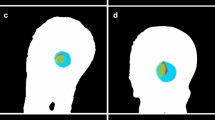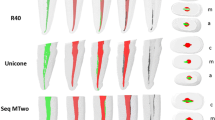Abstract
Purpose
Compare canal transportation and dentin removal using micro computed tomography (micro-CT) and measure instrumentation time in the root canal preparation of primary molars using K-files, ProDesign Logic and Reciproc files.
Methods
A representative sample of 81 root canals of primary molars was randomised into three groups: K-files (#15-40), ProDesign Logic (#25) and Reciproc (R25). A single-trained operator prepared all root canals. A standardised micro-CT evaluation was performed before and after instrumentation using the CTan® program. Instrumentation time was also recorded. Statistical analysis involved one-way ANOVA, Tukey’s post hoc test, Kruskal–Wallis test and Dunn’s test, considering a 5% level of significance.
Results
Reciproc led to more canal transportation than K-files and ProDesign Logic (p < 0.001) in middle third, whereas K-files led to the most canal transportation in the apical third (p = 0.017). ProDesign Logic and Reciproc removed less dentin on the opposite side of the root curvature in the apical third compared to K-files (p = 0.008). Instrumentation time was better with ProDesign Logic and Reciproc than K-files (p < 0.001).
Conclusion
ProDesign Logic demonstrated good results with regard to canal transportation and required less instrumentation time in primary molars. Reciproc and K-files led to the most canal transportation in the middle and apical third, respectively.
Similar content being viewed by others
References
Ahmed HM. Anatomical challenges, electronic working length determination and current developments in root canal preparation of primary molar teeth. Int Endod J. 2013;46:1011–22.
Arias A, Perez-Higueras JJ, De La Macorra JC. Differences in cyclic fatigue resistance at apical and coronal levels of Reciproc and WaveOne new files. J Endod. 2012;38:1244–8.
Davidovich E, Wated A, Shapira J, Ram D. The influence of location of local anesthesia and complexity/duration of restorative treatment on children’s behavior during dental treatment. Pediatr Dent. 2013;35:333–6.
Estrela C, Decurcio DA, Rossi-Fedele G, Silva JA, Guedes OA, Borges ÁH. Root perforations: a review of diagnosis, prognosis and materials. Braz Oral Res. 2018;32:e73.
Faul F, Erdfelder E, Buchner A, Lang AG. Statistical power analyses using G*Power 3.1: tests for correlation and regression analyses. Behav Res Methods. 2009;41:1149–60.
Fuks AB, Peretz B. Pediatric endodontics: current concepts in pulp therapy for primary and young permanent teeth. 1st ed. Cham: Springer International Publishing; 2016.
Gambill JM, Alder M, Del Rio C. Comparison of nickel-titanium and stainless-steel hand-file instrumentation using computed tomography. J Endod. 1996;22:369–75.
Hidalgo LRDC, Silva LABD, Leoni GB, Mazzi-Chaves JF, Carvalho EEDS, Consolaro A, Sousa-Neto MD. Mechanical preparation showed superior shaping ability than manual technique in primary molars - a micro-computed tomography study. Braz Dent J. 2017;28:453–60.
Kaya E, Elbay M, Yiğit D. Evaluation of the self-adjusting file system (SAF) for the instrumentation of primary molar root canals: a micro-computed tomographic study. Eur J Paediatr Dent. 2017;18:105–10.
Kummer TR, Calvo MC, Cordeiro MM, de Sousa VR, de Carvalho Rocha MJ. Ex vivo study of manual and rotary instrumentation techniques in human primary teeth. Oral Surg Oral Med Oral Pathol Oral Radiol Endod. 2008;105:84–92.
Manchanda S, Sardana D, Yiu CKY. A systematic review and meta-analysis of randomized clinical trials comparing rotary canal instrumentation techniques with manual instrumentation techniques in primary teeth. Int Endod J. 2020;53(3):333–53.
Menezes SEAC, Batista SM, Lira JOP, Melo Monteiro GQ. Cyclic fatigue resistance of WaveOne Gold, ProDesign R and ProDesign Logic files in curved canals in vitro. Iran Endod J. 2017;12:468–73.
Marceliano-Alves MF, Sousa-Neto MD, Fidel SR, Steier L, Robinson JP, Pécora JD, Versiani MA. Shaping ability of single-file reciprocating and heat-treated multifile rotary systems: a micro-CT study. Int Endod J. 2015;48:1129–36.
Moskovitz M, Tickotsky N. Pulpectomy and root canal treatment (RCT) in primary teeth: techniques and materials. In: Fuks AB, Peretz B, editors. Pediatric endodontics: current concepts in pulp therapy for primary and young permanent teeth. Cham: Springer International Publishing; 2016. p. 72–97.
Musale PK, Mujawar SAV. Evaluation of the efficacy of rotary vs hand files in root canal preparation of primary teeth in vitro using CBCT. Eur Arch Paediatr Dent. 2014;15:113–20.
Musale PK, Jain KR, Kothare SS. Comparative assessment of dentin removal following hand and rotary instrumentation in primary molars using cone-beam computed tomography. J Indian Soc Pedod Prev Dent. 2019;37:80–6.
Peters AO. Current challenges and concepts in the preparation of root canal systems: a review. J Endod. 2004;30:559–67.
Pinheiro SR, Alcalde MP, Vivacqua-Gomes N, Bramante CM, Vivan RR, Duarte MAH, Vasconcelos BC. Evaluation of apical transportation and centring ability of five thermally treated NiTi rotary systems. Int Endod J. 2018;51:705–13.
Poornima P, Disha P, Nagaveni NB, Roopa KB, Bharath KP, Neena IE. ‘Volumetric analysis of hand and rotary root canal instrumentation and filling in primary teeth using Spiral Computed Tomography’–an in vitro study. Int J Paediatr Dent. 2016;26:193–8.
Pruett JP, Clement DJ, Carnes DL Jr. Cyclic fatigue testing of nickel-titanium endodontic instruments. J Endod. 1997;23:77–85.
Radhika E, Reddy ER, Rani ST, Kumar LV, Manjula M, Mohan TA. Cone beam computed tomography evaluation of hand nickel-titanium k-files and rotary system in primary teeth. Pediatr Dent. 2017;39:319–23.
Schneider SW. A comparison of canal preparations in straight and curved root canals. Oral Surg Oral Med Oral Pathol. 1971;32:271–5.
Sealed Envelope Ltd. Simple randomisation service. https://www.sealedenvelope.com/simple-randomiser/v1/ (2018). Accessed 15 Apr 2018.
Selvakumar H, Kavitha S, Thomas E, Anadhan V, Vijayakumar R. Computed tomographic evaluation of K3 rotary and stainless-steel K-file instrumentation in primary teeth. J Clin Diagn Res. 2016;10:ZC05–08.
Smaïl-Faugeron V, Glenny AM, Courson F, Durieux P, Muller-Bolla M, Fron CH. Pulp treatment for extensive decay in primary teeth. Cochrane Database Syst Ver. 2018;5:CD003220.
Tannure PN, Gleiser R, Luiz RR, Primo LG. The influence of smear layer removal on primary tooth pulpectomy outcome: a 24-month, double-blind, randomized, and controlled clinical trial evaluation. Int J Paediatr Dent. 2012;22:369–81.
Wei Z, Cui Z, Yan P, Jiang H. A comparison of the shaping ability of three nickel-titanium rotary instruments: a micro-computed tomography study via a contrast radiopaque technique in vitro. BMC Oral Health. 2017;17:39.
Acknowledgements
The authors are grateful to the Coordination for the Improvement of Higher Education Personnel (CAPES) for financial support (financial code: 001).
Funding
This study was funded by Coordination for the Improvement of Higher Education Personnel (CAPES) (financial code: 001).
Author information
Authors and Affiliations
Contributions
All authors contributed to the study conception and design. Material preparation, data collection and analysis were performed by JCB, MPA and MB. The first draft of the manuscript was written by JCB and all authors commented on previous versions of the manuscript. All authors read and approved the final manuscript.
Corresponding author
Ethics declarations
Conflict of interest
The authors declare that they have no conflicts of interest related to this study.
Ethical approval
All procedures performed in studies involving human participants were in accordance with the ethical standards of the institutional and/or national research committee (Process No. 2,572,237) and with the 1964 Helsinki Declaration and its later amendments or comparable ethical standards.
Informed consent
Informed consent was obtained from all individual participants included in the study.
Additional information
Publisher's Note
Springer Nature remains neutral with regard to jurisdictional claims in published maps and institutional affiliations.
Rights and permissions
About this article
Cite this article
Barasuol, J.C., Alcalde, M.P., Bortoluzzi, E.A. et al. Shaping ability of hand, rotary and reciprocating files in primary teeth: a micro-CT study in vitro. Eur Arch Paediatr Dent 22, 195–201 (2021). https://doi.org/10.1007/s40368-020-00530-0
Received:
Accepted:
Published:
Issue Date:
DOI: https://doi.org/10.1007/s40368-020-00530-0




